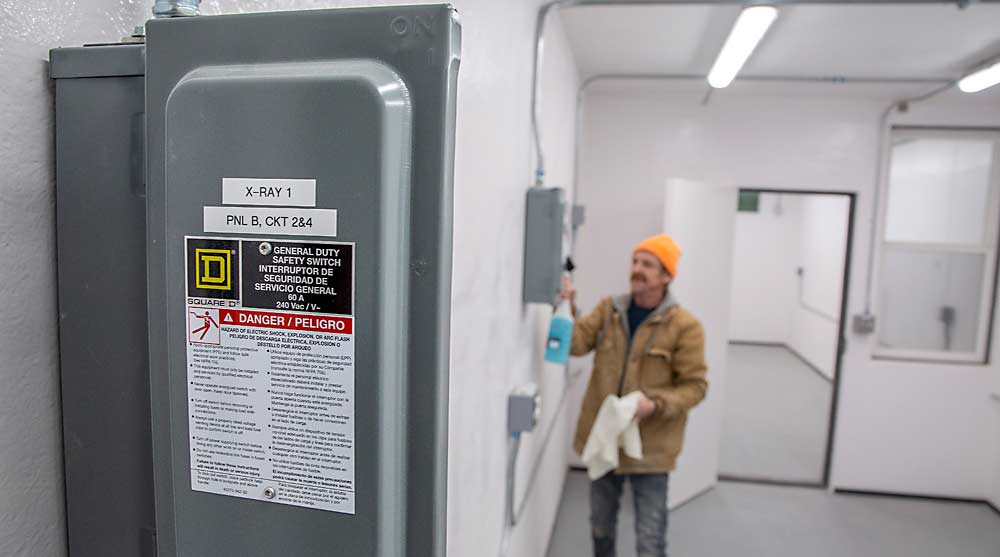[ad_1]

The tech firm behind sterile insect launch in Washington is launching a brand new manner of creating infertile codling moths.
With assist from a federal grant, M3 Agriculture Applied sciences is constructing modular X-ray services to sterilize moths as an alternative of utilizing the standard apply of exposing them to gamma rays.
The transfer might democratize the usage of sterile insect launch, a pest administration approach up till now overseen by federal nuclear authorities, stated CEO Nathan Moses-Gonzales.
“It’s a bit loopy,” Moses-Gonzales stated. “We’re making an attempt to do one thing that has classically been the (mandate) of the federal authorities.”
With the shift, M3 plans to construct its personal home provide chain of the sterile moths it at the moment imports from an irradiation facility in British Columbia, Canada. This may make its companies obtainable to extra apple orchards, pear orchards and in addition to nut and citrus crops.
The corporate goals to start out rearing its first U.S. colony by the top of this yr, he stated.
To date, M3 has constructed one unit at a building firm in Japanese Washington. The ten- by 40-foot fiberglass facility has two rooms: one for 3 X-ray machines comparable in scale to these in a dentist’s workplace, the opposite for storing chilled moths. The corporate shipped the construction to its analysis headquarters in Tempe, Arizona, the place scientists will good the X-ray sterilization course of.
The startup work is funded by a $1 million grant from the U.S. Nationwide Nuclear Safety Administration’s Workplace of Radiological Safety.
As soon as the corporate finishes the primary facility, it is going to begin constructing as many because the market calls for, setting them up close to the orchards they serve, Moses-Gonzales stated.

Historical past of success
The sterile insect approach entails releasing infertile pests to mate with a feral inhabitants, producing eggs that received’t hatch. The tactic has eradicated the screwworm cattle pest and the pink bollworm cotton pest in North America. Agriculture officers in California at the moment use sterilized navel orangeworm moths in almond trials, although it has not but been adopted commercially.
For greater than 20 years, apple and pear growers in British Columbia have used sterile codling moths on a compulsory, areawide foundation. The Canadian authorities’s 30,000-square-foot Okanagan Sterile Insect Launch Program facility in Osoyoos has helped growers to lower their use of codling moth chemical pesticides by greater than 90 p.c.
Nonetheless, pome fruit acreage in Canada has been shrinking for the previous 25 years, leaving the ability with extra capability, stated Melissa Tesche, former common supervisor. Since 2018, the ability’s board of administrators has allowed distribution of moths for trials in Washington, Michigan, New Zealand and Australia.
Holding the only contract to maneuver the bugs, M3 shifted these trials into industrial work, a departure for the federal government program by no means arrange for gross sales, Tesche stated. “The board is taking a second to deal with the enterprise aspect of this,” she stated.
The group will take new industrial distribution bids on the finish of this yr. M3 plans to use.
Sterile insect approach within the U.S.
With the imported Osoyoos moths, M3 at the moment treats about 4,500 to five,000 acres in Washington.
The sterile insect approach works properly when used together with wholesome, current administration strategies, stated Chris Adams, an Oregon State College entomologist and chair of a Northwest process drive composed to push again in opposition to a resurgence in codling moth strain. Nonetheless, most Oregon pear growers is not going to discover sterile bugs cost-effective at this level, he stated.
California has just one yr of trials on three industrial pear blocks in Sacramento and Lake counties, stated Chuck Burks, U.S. Division of Agriculture analysis entomologist in Parlier. The 2023 outcomes point out the approach is suitable with current mating disruption and mushy insecticide applications, Burks stated. This yr, he and fellow researchers plan to repeat the trials, funded by the California Pear Advisory Board.
Getting sufficient moths has been M3’s limiting issue, however establishing a gamma ray facility just like the one in Osoyoos could be subsequent to unattainable in the USA, Moses-Gonzales stated. Below the John S. McCain Nationwide Protection Authorization Act of 2019, federal nuclear authorities are required to switch the usage of cesium-137 isotopes with X-rays by 2027. Ag techies determine cobalt-60, used to irradiate moths, faces the identical destiny.
Even when the U.S. authorities allowed a facility, M3 would wish a buyer base of 20,000 acres to interrupt even, Moses-Gonzales stated. With the modular X-ray method, that threshold will drop to 1,000 acres.
The smaller services will even shorten the availability chain, permitting the moths to reach on the orchard more healthy and higher capable of compete with the wild, fertile inhabitants.
Adams is happy in regards to the X-ray methodology however desires to see extra analysis earlier than he’s positive it may well match the size required to deal with the Washington acreage below sterile insect remedy now.
“X-ray takes for much longer to attain the identical stage of sterility and requires smaller batches of bugs per remedy,” he stated.
M3 intends to proceed importing isotope-treated moths from Canada, Moses-Gonzales stated, however he expects that as manufacturing quickens, the X-ray method will finally surpass the capability of the gamma ray facility.
“It ought to make it less expensive,” Moses-Gonzales stated.
—by Ross Courtney
[ad_2]

